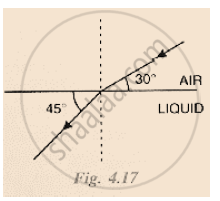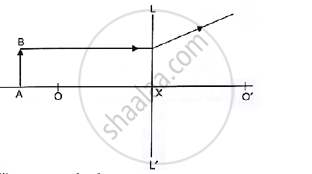Advertisements
Advertisements
प्रश्न
Define the term principal axis of a lens.
उत्तर १
It is the line joining the centers of curvature of the two surfaces of the lens.
उत्तर २
संबंधित प्रश्न
Draw a labelled ray diagram to show how a ray of light passes through a parallel sided glass block:
if it hits the glass block at an angle other than 90° (that is, obliquely to the glass block).
Describe with the help of a ray-diagram, the formation of image of a finite object placed in front of convex lens between f and 2f. Give two characteristics of the image so formed.
Name one simple optical instrument in which the above arrangement of convex lens is used.
Calculate the focal length of a convex lens which produces a virtual image at a distance of 50 cm of an object placed 20 cm in front of it.
Find the nature, position and magnification of the images formed by a convex lens of focal length 0.20 m if the object is placed at a distance of:
0.25 m
A student did an experiment with a convex lens. He put an object at different distances 25 cm, 30 cm, 40 cm, 60 cm and 120 cm from the lens. In each case he measured the distance of the image from the lens. His results were 100 cm, 24 cm, 60 cm, 30 cm and 40 cm, respectively. Unfortunately his results are written in wrong order.
What is the focal length of this lens?
How would a pencil look like if you saw it through How would a pencil look like if you saw it through
A beam of parallel light rays is incident through the holes on one side of a box and emerges out through the holes on its opposite side as shown in the diagram below:
Which of the following could be inside the box?
(a) a rectangular glass block
(b) a concave lens
(c) a convex lens
(d) a glass prism
The diagram alongside shows the refraction of a ray of light from sir to a liquid.
(a) write the values of (i) angle of incidence, (ii) angle of refraction.
(b) use snell’s law to find the refractive index of liquid with respect to air.

Study the diagram below.

what are the points O, O’ called?
State two applications of a convex lens.
A teacher sets up the stand carrying a convex lens of focal length 15 cm at 42.7 cm mark on the optical bench. He asks four students A, B, C and D to suggest the position of screen on the optical bench so that a distinct image of a distant tree is obtained almost immediately on it. The positions suggested by the students were as
A. 12.7 cm
B. 29.7 cm
C. 57.7 cm
D. 72.7 cm
The correct position of the screen was suggested by
(a) A
(b) B
(c) C
(d) D

i. Which type of microscope has the arrangement of lenses shown in the adjoining figure?
ii. Label the figure correctly.
iii. Write the working of this microscope.
iv. Where does this microscope used?
v. Suggest a way to increase the efficiency of this microscope.
Observe the following figure and complete the table:

| Points | Answer |
| (i) Position of the object | |
| (ii) Position of the image | |
| (iii) Size of the image | |
| (iv) Nature of the image |
(a) What type of a lens can be used as a magnifying glass?
(b) Show by a ray diagram the formation of a real image by simple magnifying lens.
A lens always forms an image between the object and the lens.
A lens always forms an image between the object and the lens.
State two applications of a convex lens.
State the nature and position of the object on the principal axis to obtain a real image of the same size
A candle is placed between f and 2f a convex lens. Draw a ray diagram showing the position of the image.
